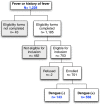Spatial epidemiology and climatic predictors of paediatric dengue infections captured via sentinel site surveillance, Phnom Penh Cambodia 2011-2012
- PMID: 24972712
- PMCID: PMC4085229
- DOI: 10.1186/1471-2458-14-658
Spatial epidemiology and climatic predictors of paediatric dengue infections captured via sentinel site surveillance, Phnom Penh Cambodia 2011-2012
Abstract
Background: Dengue is a major contributor to morbidity in children aged twelve and below throughout Cambodia; the 2012 epidemic season was the most severe in the country since 2007, with more than 42,000 reported (suspect or confirmed) cases.
Methods: We report basic epidemiological characteristics in a series of 701 patients at the National Paediatric Hospital in Cambodia, recruited during a prospective clinical study (2011-2012). To more fully explore this cohort, we examined climatic factors using multivariate negative binomial models and spatial clustering of cases using spatial scan statistics to place the clinical study within a larger epidemiological framework.
Results: We identify statistically significant spatial clusters at the urban village scale, and find that the key climatic predictors of increasing cases are weekly minimum temperature, median relative humidity, but find a negative association with rainfall maximum, all at lag times of 1-6 weeks, with significant effects extending to 10 weeks.
Conclusions: Our results identify clustering of infections at the neighbourhood scale, suggesting points for targeted interventions, and we find that the complex interactions of vectors and climatic conditions in this setting may be best captured by rising minimum temperature, and median (as opposed to mean) relative humidity, with complex and limited effects from rainfall. These results suggest that real-time cluster detection during epidemics should be considered in Cambodia, and that improvements in weather data reporting could benefit national control programs by allow greater prioritization of limited health resources to both vulnerable populations and time periods of greatest risk. Finally, these results add to the increasing body of knowledge suggesting complex interactions between climate and dengue cases that require further targeted research.
Figures





References
-
- Bhatt S, Gething PW, Brady OJ, Messina JP, Farlow AW, Moyes CL, Drake JM, Brownstein JS, Hoen AG, Sankoh O, Myers MF, George DB, Jaenisch T, Wint GRW, Simmons CP, Scott TW, Farrar JJ, Hay SI. The global distribution and burden of dengue. Nature. 2013;496:504–507. doi: 10.1038/nature12060. - DOI - PMC - PubMed
-
- United Nations Development Programme. Human Development Report. New York; London: United Nations; Eurospan; 2013.
-
- Huy R, Buchy P, Conan A, Ngan C, Ong S, Ali R, Duong V, Yit S, Ung S, Te V, Chroeung N, Pheaktra NC, Uok V, Vong S. National dengue surveillance in Cambodia 1980–2008: epidemiological and virological trends and the impact of vector control. Bull World Health Organ. 2010;88:650–657. doi: 10.2471/BLT.09.073908. - DOI - PMC - PubMed
-
- Dengue situation in Cambodia, 2012 update (National Dengue Control Programme) http://www.cnm.gov.kh/userfiles/file/Annual%20Report%202012/19_Dengue_CN....
Publication types
MeSH terms
LinkOut - more resources
Full Text Sources
Other Literature Sources
Medical

